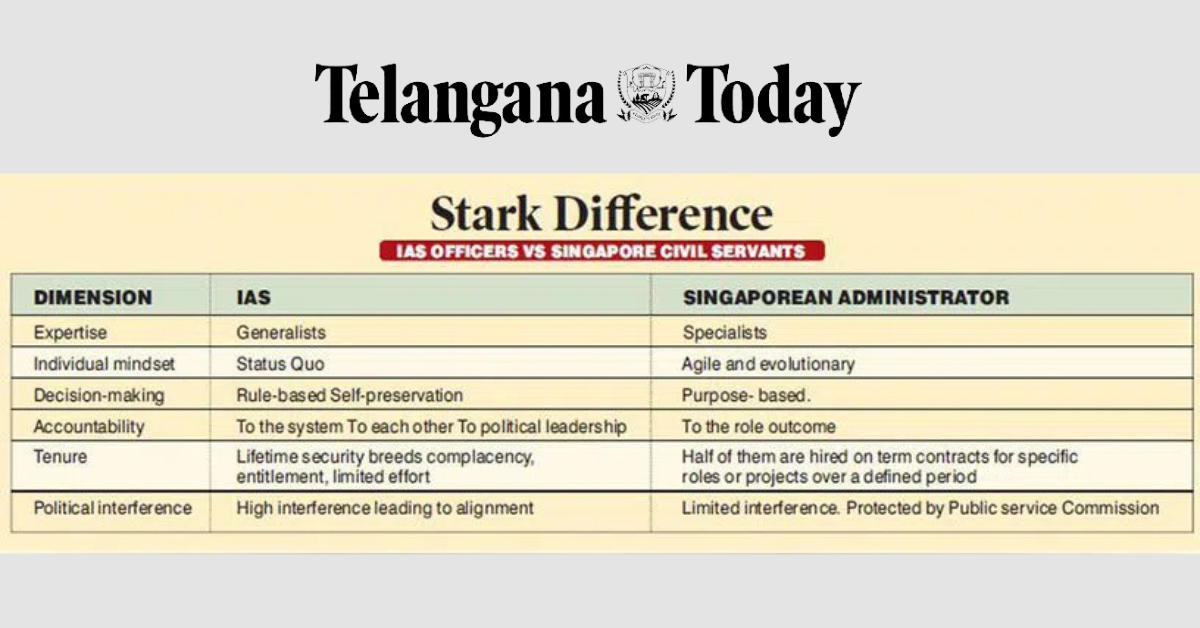
IAS cadre — it’s is time to transform from Administrators to Managers. This concept got a lot of credence when Mr Narayan Murthy argued that the Prime Minister’s vision of 2047 will require a fundamental and transformational change in the acclaimed Indian Administrative Service (IAS). He added that the IAS cadre hiring must change to management schools.
Administrator vs Manager
Before we start, let us understand the difference between an administrator and a manager. Let me start with a live example. I was travelling to Vijayawada from Hyderabad and there are several speed-breakers — many are not visible and a car or a two-wheeler driver can easily miss them. Let us assume that the car driver applies brakes suddenly and the motorcyclist behind crashes into the car and dies. Now the question arises — who built the speed-breaker? Who authorised it? On what basis was it authorised?
It is the last question that is important. The administrator will say it was authorised based on rules and that due process was followed. It’s an unfortunate accident. The manager will say the rule was set when the speed limit was 60 km per hour which was revised to 100 km per hour in the 6-lane stretches a few years ago, and the speed-breaker was meant for a school which had moved to another location. Hence, he will conclude: the problem was the lack of timely updation of the rule and school location. He would immediately appoint an expert to review the speed-breaker rules to prevent future accidents. And more importantly, ensure that fair compensation is paid to the motorcyclist and car owner.
And that is what Mr Murthy meant when he said that administrators make decisions for the status quo, while managers are evolutionists and make purpose-driven decisions.
Govt Effectiveness Index 2023
The government effectiveness index is a ranking of state capacity developed by the World Bank Group. The index of Government Effectiveness captures perceptions of the quality of public services, the quality of the civil service and the degree of its independence from political pressures, the quality of policy formulation and implementation, and the credibility of the government’s commitment to such policies. The index covers 193 countries — Singapore topped with a score of 2.36 out of a maximum of 2.5, UAE was at 12, New Zealand at 17 and Estonia scored 23.
Current IAS officers dominate the hiring process and perpetuate the existing system by hiring people who they think will fit their vision
India was ranked at 57 with a score of 0.48. Historically, the average for India from 1996 to 2023 has been only 0.02 points. The good news is that this score has improved significantly in the last few years. The bad news is that India has a long way to go to catch up with Europe or Singapore.
Civil Servants: India vs Singapore
Let’s discuss the main difference between an Indian administrator and a Singapore administrator. Why Singapore administrators? Because they are perceived to be the best. Here I am excluding corruption which seems prevalent in India because it is a very controversial issue and might hijack the main story. The other dimension for comparison reveals what is wrong with the Indian bureaucracy.
- Systemic Issues
The poor performance of the IAS cadre is not merely a product of individual mindset but a result of systemic issues rooted in colonial legacy, motivated investigations, procedural rigidity, hierarchy and centralisation, seniority-based promotion, lack of transparency, etc.
Changing for Good
Redesign the role of the cadre in the digital world: Here, the decision-making will change dramatically. Rule-based decisions will be made by algorithm based on real-time data.
- Exception decisions will be made by the manager, and this is the first major task of the cadre.
- Design decisions viz decisions required to set up a digital system and make periodic changes based on audit and review process is the second critical task of the cadre.
- The third critical task is goal alignment. Each system will have goals, and these will have to be aligned with the larger goals of the government.
- The fourth major job is to align the entire government officers team with the new way of working and system goals.
Several things must be done to make the change inevitable and permanent. Some of them are out-of-the-box and some are proven by experience of other countries:
- The biggest resistance to change comes from those who benefit from the status quo ie, the IAS officers who are in positions of power. One way to overcome their resistance is to create a new vision for the cadres like the first prime minister of Singapore Lee Kuan Yew did. Singapore’s shift from a “generalist” bureaucratic system to a “specialist-based meritocratic system” under his leadership was driven by a clear vision to create a lean, data-driven and high-performance public service.
- We need a new vision of a cadre that serves the common man rather than themselves and the privileged. We need a new profile for the cadre — people who are experts, those who serve and manage more and administer less.
- Stop hiring IAS cadre for five years to build an alternative cadre. Till such time, hire retired, performing and willing officers on contract.
- Redesign and relaunch the cadre as Indian Public Management Service or IPMS. While 75% must be specialists in one or two domains based on the demand, the remaining may be generalists.
- Discontinue the current UPSC model of hiring and set up a new system like Public Service Selection Board which assesses personality, attitude to serve and tech savviness.
- The entire selection process is skewed today because the current IAS officers dominate the hiring process and perpetuate the existing system by hiring people who they think will fit their current vision. We need a selection board independent of IAS officers to select the next generation of IAS officers who fit the new vision.
- The current exam system of prelims and mains is outdated. Look more for attitude and less for intellectual power which can be acquired or learnt or hired. Create assessment models which measure less of what you know or say and more of what you believe or do. The current system of assessment of personality through board interviews is very subjective. All these three exams — prelims mains and interviews — are irrelevant in the generative AI world where knowledge is on tap. We need open-book exams. The correct hiring profile can be easily generated from those in the current IAS and who fit the new vision.
- Hire everyone for a short service tenure and provide permanent tenure only after a transparent evaluation of performance and contribution and alignment with the new vision. We can weed out those who do not make the grade and whose value systems are suspect.
- Stop batch-based promotion and batch identity of officers after seven years in the cadre. For example, the Tata Administrative Service cadre got a head start for a few years but thereafter they had to compete without batch identity.
- Lastly, increase transparency in decision-making and allow for mistakes in decisions. Witch-hunting must stop and there must be a period of limitation for decisions made.
- Lateral hiring programme must be encouraged and enlarged.
Replacing entrenched systems like the IAS requires a mix of political courage, structural reform and cultural change. The best approach is to create a parallel system, gradually phase out the old, and use digital transformation, transparency and accountability to sustain the change.

